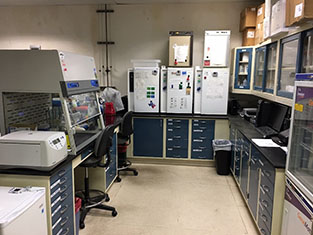Analytical Services Laboratory
Located at A.E. Wood Fish Hatchery
505 Staples Road, Building 2
San Marcos, Texas 78666
Telephone (512) 353-7332
Mission
The Analytical Services Lab (ASL) is the centralized laboratory hub for Texas Parks and Wildlife Departments’ (TPWD) Inland Fisheries Division. Research and service focuses on the improvement of fisheries, detection and treatment of disease, and conservation of aquatic resources in Texas. Laboratory staff consists of a geneticist, microbiologist/fish health specialist, a laboratory technician, as well as interns and volunteers.
Genetics
 The ASL genetics branch performs applied and basic research using population genetic and genomic approaches. This includes the discovery of novel genetic markers for use in identifying species and their hybrids, placing groups in phylogenetic context, resolving genetic structure and gene flow within and among populations, estimating relatedness among individuals, and exploring the genetic architecture underlying specific phenotypes. These methods facilitate the identification and tracking of individuals in captive and wild settings, making inferences about behavior, managing captive brood-stocks, assessing program effectiveness, and identifying and conserving native lineages.
The ASL genetics branch performs applied and basic research using population genetic and genomic approaches. This includes the discovery of novel genetic markers for use in identifying species and their hybrids, placing groups in phylogenetic context, resolving genetic structure and gene flow within and among populations, estimating relatedness among individuals, and exploring the genetic architecture underlying specific phenotypes. These methods facilitate the identification and tracking of individuals in captive and wild settings, making inferences about behavior, managing captive brood-stocks, assessing program effectiveness, and identifying and conserving native lineages.
For additional information, contact Dijar Lutz-Carrillo.
Fish Health and Microbiology
 The ASL fish health branch focuses on fish hatchery inspections, fish diseases, disease treatments, and the detection of invasive species. Outbreaks of largemouth bass virus (LMBV) and "golden algae" (Prymnesium parvum) have affected Texas fisheries over several years and zebra mussels are beginning to invade southern latitude water bodies including those in Texas. The lab analyzes fish found in the wild for viruses, bacteria, parasites, and other microbes capable of causing disease. The lab also tests fish grown in state hatcheries to avoid spreading potential pathogens to the natural environment as well as diagnosing diseases and providing treatment options to improve hatchery production. Standard protocols for detecting pathogens are adapted from accepted procedures published by the American Fisheries Society Fish Health Section and the U.S. Fish and Wildlife Service.
The ASL fish health branch focuses on fish hatchery inspections, fish diseases, disease treatments, and the detection of invasive species. Outbreaks of largemouth bass virus (LMBV) and "golden algae" (Prymnesium parvum) have affected Texas fisheries over several years and zebra mussels are beginning to invade southern latitude water bodies including those in Texas. The lab analyzes fish found in the wild for viruses, bacteria, parasites, and other microbes capable of causing disease. The lab also tests fish grown in state hatcheries to avoid spreading potential pathogens to the natural environment as well as diagnosing diseases and providing treatment options to improve hatchery production. Standard protocols for detecting pathogens are adapted from accepted procedures published by the American Fisheries Society Fish Health Section and the U.S. Fish and Wildlife Service.
For additional information, contact Greg Southard.
Water Quality
In warmwater fish culture, hatchery biologists increase production by enhancing the natural productivity of the aquatic environment. This can be a delicate balancing act. Fertilizing a pond enhances zooplankton abundance for young fish, but over-fertilization can reduce dissolved oxygen to levels where fish growth and even survival may be impaired. By-products of fish growth must also be carefully monitored along with the pH of the water. The ASL water quality branch performs these services, evaluates ionic profiles of select water bodies, ensures hatchery discharge water meets state and federal standards, and runs periodic quality checks on state hatcheries' testing procedures.
For additional information, contact Mignon Fitzpatrick.

Information collection, reporting and research are produced with support from the federal Sport Fish Restoration program.